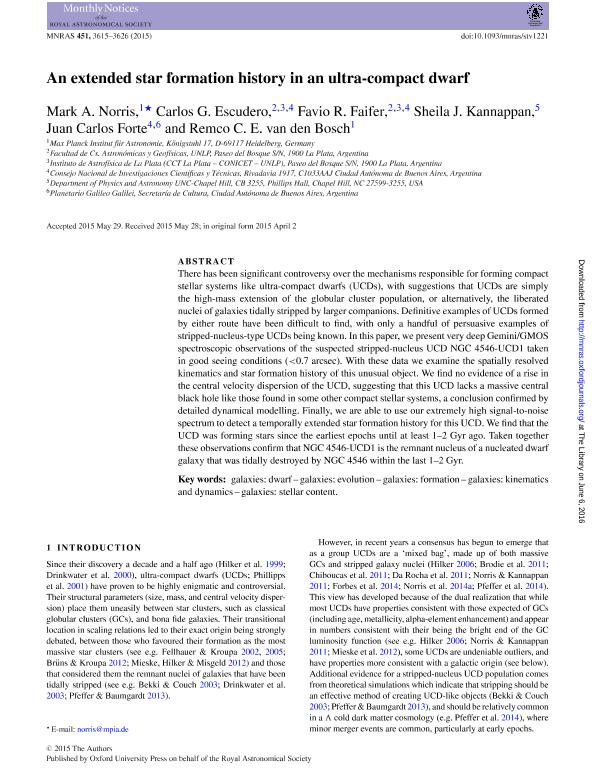Artículo
An extended star formation history in an ultra-compact dwarf
Norris, Mark A. ; Escudero, Carlos Gabriel ; Faifer, Favio Raúl
; Faifer, Favio Raúl ; Kannappan, Sheila J.; Forte, Juan Carlos
; Kannappan, Sheila J.; Forte, Juan Carlos ; van den Bosch, Remco C. E.
; van den Bosch, Remco C. E.
 ; Faifer, Favio Raúl
; Faifer, Favio Raúl ; Kannappan, Sheila J.; Forte, Juan Carlos
; Kannappan, Sheila J.; Forte, Juan Carlos ; van den Bosch, Remco C. E.
; van den Bosch, Remco C. E.
Fecha de publicación:
06/2015
Editorial:
Oxford University Press
Revista:
Monthly Notices Of The Royal Astronomical Society
ISSN:
0035-8711
Idioma:
Inglés
Tipo de recurso:
Artículo publicado
Clasificación temática:
Resumen
There has been significant controversy over the mechanisms responsible for forming compact stellar systems like ultra compact dwarfs (UCDs), with suggestions that UCDs are simply the high mass extension of the globular cluster (GC) population, or alternatively, the liberated nuclei of galaxies tidally stripped by larger companions. Definitive examples of UCDs formed by either route have been difficult to find, with only a handful of persuasive examples of stripped-nucleus type UCDs being known. In this paper we present very deep Gemini/GMOS spectroscopic observations of the suspected stripped nucleus UCD NGC 4546-UCD1 taken in good seeing conditions (0.7´´). With these data we examine the spatially resolved kinematics and star formation history of this unusual object. We find no evidence of a rise in the central velocity dispersion of the UCD, suggesting that this UCD lacks a massive central black hole like those found in some other compact stellar systems, a conclusion confirmed by detailed dynamical modelling. Finally we are able to use our extremely high signal to noise spectrum to detect a temporally extended star formation history for this UCD. We find that the UCD was forming stars since the earliest epochs until at least 1-2 Gyr ago. Taken together these observations confirm that NGC 4546-UCD1 is the remnant nucleus of a nucleated dwarf galaxy that was tidally destroyed by NGC 4546 withinthe last 1-2 Gyr.
Palabras clave:
Star Clusters
,
Dwarfs
,
Formation of Galaxies
,
Evolution of Galaxies
Archivos asociados
Licencia
Identificadores
Colecciones
Articulos(IALP)
Articulos de INST.DE ASTROFISICA LA PLATA
Articulos de INST.DE ASTROFISICA LA PLATA
Citación
Norris, Mark A. ; Escudero, Carlos Gabriel; Faifer, Favio Raúl; Kannappan, Sheila J.; Forte, Juan Carlos; et al.; An extended star formation history in an ultra-compact dwarf; Oxford University Press; Monthly Notices Of The Royal Astronomical Society; 451; 4; 6-2015; 3615-3626
Compartir



